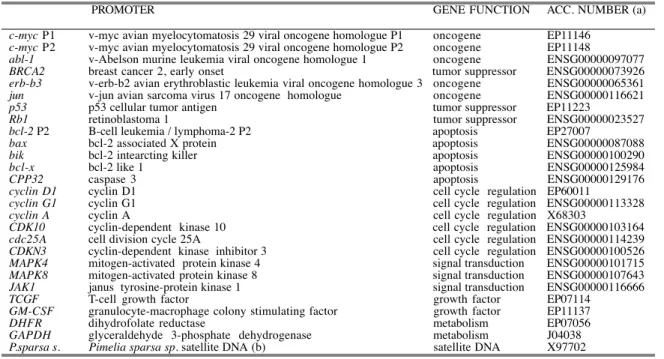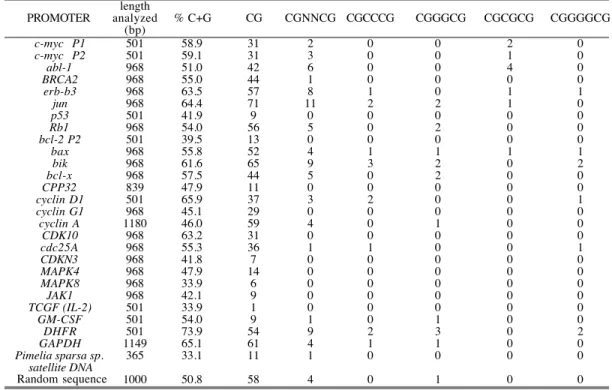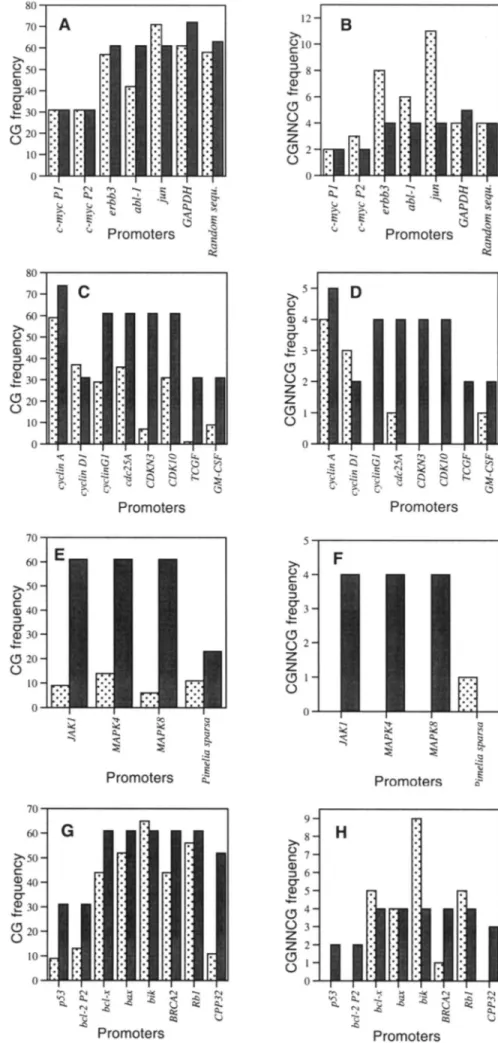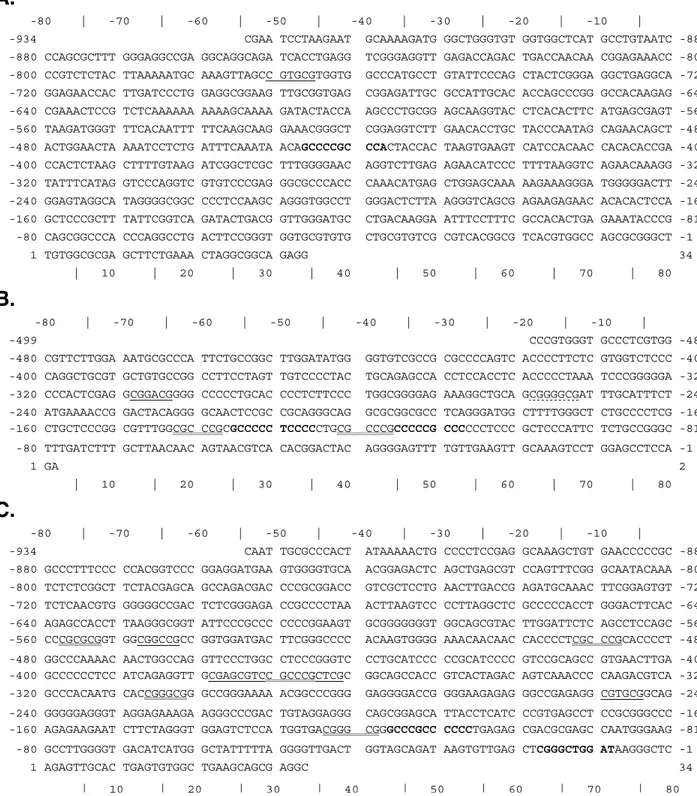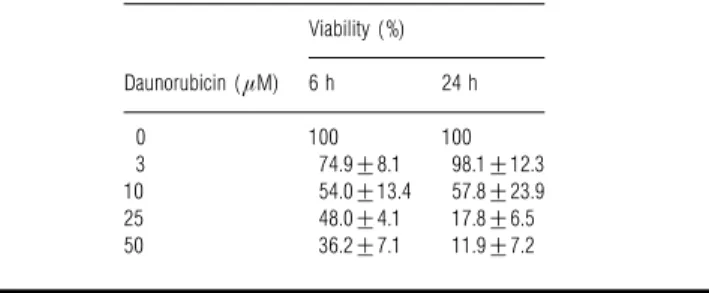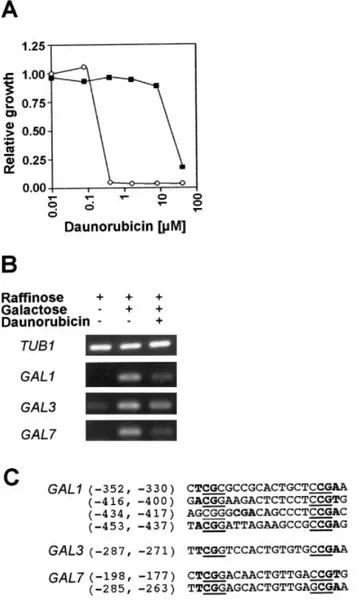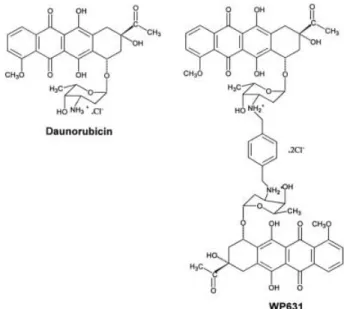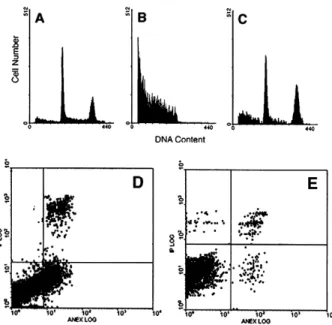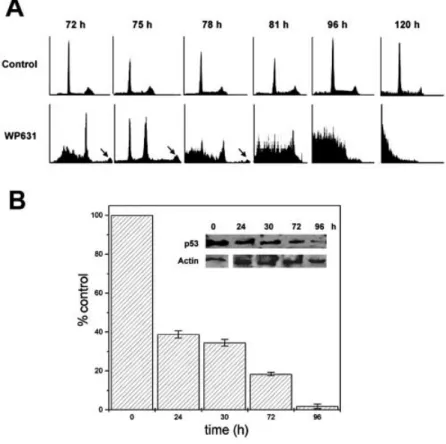ANEXO II
Occurrence of DNA Sequences Specifically Recognized
by Drugs in Human Promoters
http://www.jbsdonline.com Abstract
Several DNA-binding drugs are being developed to create tailored molecules which can dis-criminate among the different sequences of the whole genome. By discriminating among specific sites in DNA, these molecules may provide optimal drug therapy. The complete sequencing of the human genome offers a wealth of DNA targets to be analyzed as potential drug-binding sites. To increase our understanding of DNA-drug interactions and their selec-tivity, we have studied the relative and absolute occurrence of CG-rich sequences, of vari-ous lengths, in human gene promoters. In several promoters, including those of oncogenes, cell cycle regulation factors, tumor suppressors and housekeeping genes, the presence of potential binding sites containing CpG steps (in which many drugs are known to intercalate) is variable, but in many cases these sites are not randomly distributed. Sequences 6-7 base pairs in length, like CGCCCG or CGCCCCG, occur only once in some promoters, thus they may be potentially specific therapeutic targets.
Introduction
The design of small molecules that recognize specific sequences in DNA is con-sidered a reasonable approach to drug development (1-5). DNA-binding com-pounds can inhibit the binding of several protein factors to DNA and DNA-associ-ated enzymes. Therefore, they may have a therapeutic effect including anti-cancer activity. With these considerations in mind, several groups have devised high-affin-ity binding ligands (5-8).
Small molecules do not provide ideal DNA-binding drugs for targeting a unique sequence in the genome (9). However, despite their low specificity, many of these ligands are effective antitumor drugs, and they are currently used in chemotherapy (10). There is a clear need to develop molecules that can permeate cells and bind selectively to extended sequences of DNA, thereby ideally regulating the tran-scriptional activity of the intended genes (11-13). We should consider better to tar-get the DNA responsible for the disease (the ‘pathogenic genes’) for example by controlling their expression at the transcription level, and not the downstream effects.
The sequencing of the human genome has brought with it a wealth of information about potential DNA targets. In living organisms the recognition of the sequence information on DNA involves the binding of proteins to specific control regions in genes. Therefore, any drug aimed to disrupt a DNA-protein complex must compete to bind to DNA in order to exert its therapeutic effects. Consequently, the control of gene expression at the transcription level is a promising field of research and drug development (3, 11, 12).
Some experimental classes of drugs are currently being investigated to ideally
cre-Journal of Biomolecular Structure & Dynamics, ISSN 0739-1102 Volume 19, Issue Number 4, (2002) ©Adenine Press (2002)
Sylvia Mansilla
José Portugal
Departamento de Biología Molecular y Celular. Instituto de Biología Molecular de Barcelona, CSIC Jordi Girona, 18-26 08034 Barcelona, Spain
669
Tel. 34- 93- 400 61 76 Fax 34- 93- 204 59 04 E-mail: [email protected]ate tailored molecules that can bind to specific sites in the whole genome, with both high affinity and sequence discrimination. However, the number of drugs that rec-ognize more than about four base pairs is still limited (6). Many approaches to tar-geting DNA involve the extension of molecular interactions in the minor groove, and have produced a new class of DNA binding compounds, the lexitropsins or polyamide dimers (14-16). It has recently been shown that some unfused aromatic dications can also recognize a DNA target in a strong-highly-cooperative mode and permit both GC and AT base pairs in the binding site (4).
A different, yet complementary approach known as “Modular Design Approach” is based on the incorporation of distinct classes of ligands into a single molecule. This process involves identifying existing motifs that bind to DNA, assessing them for sequence-selectivity, and assembling them with other created motifs to construct tight-binding ligands (17). This approach, considers not only the structures of relat-ed complexes/molecules, but also the thermodynamics and kinetics of complex for-mation. Following this design strategy, and using monomeric anthracyclines, bis-intercalating molecules that occupied a greater number of base pairs have been designed and synthesized, thus attaining a stringent recognition relative to the monomer (2, 18). A major advantage of the modular design, as made for some bistintercalating anthracyclines, is the simplification of structure-based design process. For example, this strategy produced a DNA-binding drug, bisanthracy-cline WP631, which displays a very tight binding affinity, and it has a binding con-stant close to that of many DNA-binding protein factors (2, 19).
At first glance, it could be argued that the development of intercalating drugs to tar-get single sites in the whole genome is hampered by the fact that their chro-mophores only interact with two base pairs (9). Although there is a clear preference of almost all known intercalating moieties for CpG steps in DNA (20, 21), the well-described intercalating moieties can be used to design drugs to bind more favorably to GC-rich sequences in gene promoters.
Drugs that bind to CpG-containing tracts in DNA can be used to gain additional discriminatory properties for the intended therapeutic drug. Because intercalating chromophores are ‘exquisitely’ limited in selecting location, the binding to erro-neous sequences should be negligible. In this way, the synthesis of polyintercala-tors is advantageous because they reduce the number of wrongly recognized sequences, and could create molecules of sufficient length to target unique sites in the human genome. Studies of bisintercalator and polyintercalator DNA-binding ligands has provided us with some promising results (2, 6, 20, 22). There are grounds to consider that variation in the transcript level of several genes may be related to the mechanisms of drug sensitivity (23). Therefore, targeting the pro-moter regions of genes involved in the development of cancer can be regarded as axiomatic (1).
Here, we analyzed the occurrence of CG-rich sequences expanding from two to up seven-eight base pair length in the binding site. We have sought to verify the fre-quency with which potential drug-binding sites, in which intercalation would take place, are found in human genome.
Given the sequence preference binding observed for these molecules, we analyzed CpG-containing DNA sequences in 26 human gene promoters. We also defined whether increasing the length in the reading frame provided unique targets. Conceptually, our study could be used to provide guidelines for future efforts to develop sequence-specific CG-binding agents with improved biological activity.
670
Materials and Methods
Human proximal promoter sequences.
The proximal regions of 26 promoters were used to analyze the availability of potential binding sites containing the CpG step. Intercalation of DNA-binding drugs mainly occurs in CpG-containing tracts (6, 20).
To avoid bias in the selection of promoters, we used two complementary approach-es. We selected genes that participate in distinct aspects of cell behavior, and that may be relevant in cancer control and development. We considered promoters of genes related to: apoptosis, cell cycle regulation, tumor suppression, plus a house-keeping gene, (glyceraldehyde 3-phosphate dehydrogenase (GAPDH)), commonly used as a control in gene expression analyses. We also analyzed an unrelated satel-lite DNA (24) and a 1000-bp random DNA sequence. We did not choose the pro-moters beforehand, but considered some of those which correspond to the genes available as components of the Atlas-Nylon Human Trial Array (Clontech Laboratories, Palo Alto, CA). The promoters analyzed, and the function of their gene related products, are indicated in Table I.
Promoter sequences were retrieved, when available, from the eukaryotic promot-er database (25), which contains an annotated collection of RNA polympromot-erase II pro-moters (accessible at: http://www.epd.isb-sib.ch); while other propro-moters were retrieved from GenBank (http://www.ncbi.nih.gov). The remaining promoters were obtained from the Human Genome Server (Project Esembl, the Sanger Center; http://www.ensembl.org), from which the desired promoter regions were hand-copied directly. The lengths of the regions analyzed varied because of the inherent difficulties in accessing sequences of longer upstream fragments, or because of ambiguities (i.e., partial sequence availability for some promoters in the databas-es). Table I shows the accession numbers for all promoters.
Analysis of base content and frequency of the different sequences.
The promoter sequences were saved in plain text format using Microsoft Word 98
671
Drug Recognition Sequences
in Human Promoters
Table I Description of the human gene promoters analyzed.
PROMOTER GENE FUNCTION ACC. NUMBER (a)
c-myc P1 v-myc avian myelocytomatosis 29 viral oncogene homologue P1 oncogene EP11146
c-myc P2 v-myc avian myelocytomatosis 29 viral oncogene homologue P2 oncogene EP11148
abl-1 v-Abelson murine leukemia viral oncogene homologue 1 oncogene ENSG00000097077
BRCA2 breast cancer 2, early onset tumor suppressor ENSG00000073926
erb-b3 v-erb-b2 avian erythroblastic leukemia viral oncogene homologue 3 oncogene ENSG00000065361
jun v-jun avian sarcoma virus 17 oncogene homologue oncogene ENSG00000116621
p53 p53 cellular tumor antigen tumor suppressor EP11223
Rb1 retinoblastoma 1 tumor suppressor ENSG00000023527
bcl-2 P2 B-cell leukemia / lymphoma-2 P2 apoptosis EP27007
bax bcl-2 associated X protein apoptosis ENSG00000087088
bik bcl-2 intearcting killer apoptosis ENSG00000100290
bcl-x bcl-2 like 1 apoptosis ENSG00000125984
CPP32 caspase 3 apoptosis ENSG00000129176
cyclin D1 cyclin D1 cell cycle regulation EP60011
cyclin G1 cyclin G1 cell cycle regulation ENSG00000113328
cyclin A cyclin A cell cycle regulation X68303
CDK10 cyclin-dependent kinase 10 cell cycle regulation ENSG00000103164
cdc25A cell division cycle 25A cell cycle regulation ENSG00000114239
CDKN3 cyclin-dependent kinase inhibitor 3 cell cycle regulation ENSG00000100526
MAPK4 mitogen-activated protein kinase 4 signal transduction ENSG00000101715
MAPK8 mitogen-activated protein kinase 8 signal transduction ENSG00000107643
JAK1 janus tyrosine-protein kinase 1 signal transduction ENSG00000116666
TCGF T-cell growth factor growth factor EP07114
GM-CSF granulocyte-macrophage colony stimulating factor growth factor EP11137
DHFR dihydrofolate reductase metabolism EP07056
GAPDH glyceraldehyde 3-phosphate dehydrogenase metabolism J04038
P.sparsa s. Pimelia sparsa sp. satellite DNA (b) satellite DNA X97702
(a) Accession number corresponding to the different promoter/gene banks, as described in Materials and Methods. (b) An unrelated A+T-rich satellite DNA of the beetle Pimelia sparsa sparsa used as a control.
for Macintosh. We used the Edit Find menu to locate the different tracts of nucleotides in the DNA sequences. To easy comparisons, several sequences were also analyzed using the FindPatterns and Compare programs in the Wisconsin GCG Package (Genetics Computer Group, Madison, Wis.).
Calculations were made on the frequency of occurrence of the different sequences in DNA in actual human gene promoters. In this way, we determined the occur-rence of certain sequences without assuming that the overall sequence may be treat-ed as chemically random, as classically undertaken in DNA-protein interactions (26, 27). We studied the four types of base-pairs in DNA, which could be read by a drug through the minor groove, and thus a particular tract can be recognized directly (28).
Nonetheless, for the sake of comparison, we also calculated the theoretical length of DNA that could be recognized as a unique sequence of a human cell. A random distribution of base pairs was assumed in the promoter (26, 27, 29) and the expect-ed frequency calculatexpect-ed.
If we consider that the overall base composition is random (A, C, T and G equally represented) the probability of a particular base occurring at a certain position (Pt) can be defined as:
Pt = Pn x N
where Pn is (0.25)y, in which y corresponds to the number of bases in the binding site. In the human genome N is around 3 x 109; or N takes the value of the length, in nucleotides, of any of the promoters studied.
When the two central bases were unambiguously defined, as, for example, in CGCCCG, this involves the following calculation:
Pt = Pn x N = (0.25)6x N
(for N= 968 Pt is approx. 0.2; for N= 501 Pt is approx. 0.1 —i.e., twice in about 10 000 bases—; and for the whole genome it should occur around 7.3 x 105times). However, for a random distribution, the probability of occurrence of the hexanu-cleotide CGNNCG (in which N can be any of the four bases) was defined as:
Pt = Pn x N = (0.25)4x N
in which y = 4, because the probability of N (any base) equals 1.
(for N= 968 Pt is approx. 4; for N= 501 Pt is approx. 2; and for the whole genome the sequence should occur 3.5 x 107times).
Hence, a binding site of 15-16 bases would be required for any sequence to be ran-domly distributed, because:
Pt = Pn x N = (0.25)16x 3x109≈ 1
These calculations were used to easy comparisons with the frequencies observed (see below). Therefore, no correction was performed on the fact that in high eukaryotic cells the A+T fraction represents about 60% of base composition (29). (Indeed, since a sequence can occur in either DNA strand, the probability of find-ing it should be multiplied by a factor of 2. However, since our theoretical approach was mainly on the presence of inverted repeats like CGNNCG, we only analyzed one of the strands, because these sites are equivalent for both strands).
672
Although, our calculations of the expected frequencies of any tract can be consid-ered somewhat simplified (27, 29), it was a useful approach for comparisons with the actual sequences observed in the distinct promoters. Here we took specificity to be the occurrence of a number and composition of certain bases (for example the presence of CpG steps) required to define a unique binding site in gene promoters. We also searched for potential binding sites for the Sp1 transcription factor, which recognizes a CG-rich sequence in promoters (30), using ‘TESS: Transcription ele-ment search software on the www’ available at: http://www.cbil.upenn.edu/tess (Match filters: 10% maximum allowable mismatch, 10 minimum element length and 12.0 minimum lg-likelihood).
Results
Table II displays the frequency of occurrence of CG-containing DNA tracts of dif-ferent lengths in several promoters. Among them there is the housekeeping gene GAPDH, commonly used as a control in gene transcription experiments in vivo. For the sake of comparison, this table also presents a 1000-bp random DNA sequence, and the satellite DNA unit of Pimelia sparsa-sparsa (24) as a model of an unrelat-ed-AT-rich DNA sequence.
The frequency of the sequences in the promoters was not uniform. Figure 1 shows eight panels corresponding to the frequencies with which some of the analyzed CG-rich tracts occurred. The promoters were arranged in panels mainly according to their functions, as described in Table I. All promoters contained one or more CpG steps, in which an intercalator can be accommodated (20). Frequencies were com-pared with those expected for a random distribution (see Materials and Methods). Panels A, C, E and G show the clustering of promoters according to their basic function in a living cell (Table I). Panels B, D, F and H are equivalent to the other four panels but show the occurrence of a CGNNCG in one strand of the deoxyri-bonucleic acid. We calculated whether the frequencies observed were deviated from the random distribution. We also analyzed the cases in which the defined
673
Drug Recognition Sequences
in Human Promoters
Table II
Nucleotide composition and frequency of occurrence of various CG-rich tracts in human promoters. Sequence frequencies were calculated by direct counting from the promoter sequences. Two unrelated sequences are also shown for the sake of comparison.
PROMOTER analyzedlength
(bp) % C+G CG CGNNCG CGCCCG CGGGCG CGCGCG CGGGGCG c-myc P1 501 58.9 31 2 0 0 2 0 c-myc P2 501 59.1 31 3 0 0 1 0 abl-1 968 51.0 42 6 0 0 4 0 BRCA2 968 55.0 44 1 0 0 0 0 erb-b3 968 63.5 57 8 1 0 1 1 jun 968 64.4 71 11 2 2 1 0 p53 501 41.9 9 0 0 0 0 0 Rb1 968 54.0 56 5 0 2 0 0 bcl-2 P2 501 39.5 13 0 0 0 0 0 bax 968 55.8 52 4 1 1 1 1 bik 968 61.6 65 9 3 2 0 2 bcl-x 968 57.5 44 5 0 2 0 0 CPP32 839 47.9 11 0 0 0 0 0 cyclin D1 501 65.9 37 3 2 0 0 1 cyclin G1 968 45.1 29 0 0 0 0 0 cyclin A 1180 46.0 59 4 0 1 0 0 CDK10 968 63.2 31 0 0 0 0 0 cdc25A 968 55.3 36 1 1 0 0 1 CDKN3 968 41.8 7 0 0 0 0 0 MAPK4 968 47.9 14 0 0 0 0 0 MAPK8 968 33.9 6 0 0 0 0 0 JAK1 968 42.1 9 0 0 0 0 0 TCGF (IL-2) 501 33.9 1 0 0 0 0 0 GM-CSF 501 54.0 9 1 0 1 0 0 DHFR 501 73.9 54 9 2 3 0 2 GAPDH 1149 65.1 61 4 1 1 0 0 Pimelia sparsa sp. satellite DNA 365 33.1 11 1 0 0 0 0 Random sequence 1000 50.8 58 4 0 1 0 0
674
Mansilla & Portugal
Figure 1: Column graphs showing the frequency of occurrence of the CpG step (panels A, C, E and G) or the CGNNCG tract (panels B, D, F and H) in the prox-imal region of several human promoters. (!): observed frequency, ("): calculated frequency, per-formed as described in Materials and Methods. A and B: oncogene promoters plus GADPH, and a random DNA sequence. C to F: genes involved in signal trans-duction plus an unrelated satellite DNA from Pimelia
sparsa sparsa. G and H: gene tumor suppressors and genes involved in apoptosis. Further details on the dif-ferent promoters are indicated in Table I.
sequences were unique for a determined promoter, as well as the likely presence of such sites in the complete genome.
As expected (9, 27, 29), the observed frequencies of the different GC-rich tracts did not show an average distribution of the four nucleotides. Furthermore, in several promoters the 6 bp-long sequence CGNNCG, which contains an ambiguous/unde-fined NN, was present once or twice only, or it was even absent (see, for example, the BRCA2 (Figure 2A), GM-CSF and cdc25A promoters (Table II)). In contrast, the promoter of jun oncogene (31) contained the sequence eleven times (Figure 1B). Another example of clear deviation between observed and expected frequen-cies in CG-rich tracts was provided by the MAPK4 promoter (Figures 1E and F). This is the promoter of a kinase that is activated in response to the stimulation of cell growth differentiation, among other stimuli (32). In the random sequence, the frequency of CGNNCG was slightly higher than the expected random distribu-tion, whereas in the AT-rich satellite of P. sparsa the frequency of CpG was sig-nificantly lower, as expected from the low percentage of cytosines plus guanines (Table II). It is worth mentioning that these results reveal that neither the random distribution, nor any general mathematical model (26), can reliably reflect the occurrence of CpG-containing sites in promoters.
Our results also allowed us to compare the effect of a more concrete definition of the nucleotides in the central part of CGNNCG. In this context, Table II shows the frequencies observed for the CGCCCG and CGGGCG tracts. This major accuracy in the study of the occurrence of different sequences in the center of the binding site provided a clear example of how a mismatch in the reading frame (i.e., the absence of the ability in a drug binding to DNA to discriminate between the four bases) reduced the sequence selectively, as it may also reduce the total affinity of the drug (33). In this respect, an outstanding observation was that the eleven 6 bp-long sites in the jun promoter (Table II and Figure 1) were reduced to two when a central GG was considered. The eight CGNNCC sites found in the erb-b3 pro-moter, whose product is involved in the pathogenesis of some malignancies in breast cells (34), became only one CGCCCG, because a better recognition-speci-ficity was achieved for the intermediate nucleotides (Table I and Figure 1). An illustrative example of the possibilities offered by a bisintercalating molecule that expands about six base pairs, is provided by the cyclin D1 promoter (35). The 37 occurrences of a CpG step (Table II and Figure 1C) became 3 CGNNCG tracts (Figure 1D), but a better definition of the central nucleotides in the binding site within the proximal 500-bases of its promoter built up a unique CGGACG, and CGGGCG was not present, while the longer CGGGGCG occurred once.
Another example of the extent to which the definition of the central two bases can be fundamental in discriminating ability was provided by the bax promoter. This is the promoter of a gene that is involved in tumor development because its overex-pression reduces apoptotic death (36). In the bax promoter CGCCCG and CGGGCG occurred once. Indeed, a larger CGGGGCG tract was still found once. The well-characterized breast cancer susceptibility gene BRCA2 (37) is another example of a promoter with a unique CGTGCG (Figure 1F and Table II). Additional examples of how CpG intercalating drugs that recognize a 6-bp sequence might discriminate for unique sites in promoters are shown in Table II. The oncogene abl-1, which is involved in the development of chronic myelogenous leukemia (38), contained six CGNNCG sequences in the 1000 bp, upstream from initiation site. If the sequence were represented randomly, we would expect to find it four times (Figure 1B); however, only one CGCGCG was observed.
In living cells, many promoters contain Sp1 binding sites (25, 30). This protein rec-ognizes a CG-rich DNA sequence and is involved in the transactivated transcrip-tion of some genes (39). The bisintercalating anthracycline WP631 has provided
675
Drug Recognition Sequences
in Human Promoters
previous experimental evidence that a drug binding about 6 bp can strongly inhib-it the activated transcription in vinhib-itro (12), by direct interaction winhib-ith the Sp1-binding site. Targeting of Sp1-Sp1-binding sites could be of potential therapeutic inter-est (19). Some of the genes studied which contain CGNNCG sites in their promot-ers present an Sp1-responsive element (determined as described in Materials and Methods). This is the case for the abl-1, BRCA2, erb-b3, cdc25A and jun promot-ers. Figure 2 shows the sequence of the proximal region of three of the these pro-moters, in which some prominent CG-tracts, and putative Sp1 binding sites, are indicated
676
Mansilla & Portugal
A.
-80 | -70 | -60 | -50 | -40 | -30 | -20 | -10 |
-934 CGAA TCCTAAGAAT GCAAAAGATG GGCTGGGTGT GGTGGCTCAT GCCTGTAATC -881 -880 CCAGCGCTTT GGGAGGCCGA GGCAGGCAGA TCACCTGAGG TCGGGAGGTT GAGACCAGAC TGACCAACAA CGGAGAAACC -801 -800 CCGTCTCTAC TTAAAAATGC AAAGTTAGCC GTGCGTGGTG GCCCATGCCT GTATTCCCAG CTACTCGGGA GGCTGAGGCA -721 -720 GGAGAACCAC TTGATCCCTG GAGGCGGAAG TTGCGGTGAG CGGAGATTGC GCCATTGCAC ACCAGCCCGG GCCACAAGAG -641 -640 CGAAACTCCG TCTCAAAAAA AAAAGCAAAA GATACTACCA AGCCCTGCGG AGCAAGGTAC CTCACACTTC ATGAGCGAGT -561 -560 TAAGATGGGT TTCACAATTT TTCAAGCAAG GAAACGGGCT CGGAGGTCTT GAACACCTGC TACCCAATAG CAGAACAGCT -481
-480 ACTGGAACTA AAATCCTCTG ATTTCAAATA ACAGCCCCGC CCACTACCAC TAAGTGAAGT CATCCACAAC CACACACCGA -401
-400 CCACTCTAAG CTTTTGTAAG ATCGGCTCGC TTTGGGGAAC AGGTCTTGAG AGAACATCCC TTTTAAGGTC AGAACAAAGG -321 -320 TATTTCATAG GTCCCAGGTC GTGTCCCGAG GGCGCCCACC CAAACATGAG CTGGAGCAAA AAGAAAGGGA TGGGGGACTT -241 -240 GGAGTAGGCA TAGGGGCGGC CCCTCCAAGC AGGGTGGCCT GGGACTCTTA AGGGTCAGCG AGAAGAGAAC ACACACTCCA -161 -160 GCTCCCGCTT TATTCGGTCA GATACTGACG GTTGGGATGC CTGACAAGGA ATTTCCTTTC GCCACACTGA GAAATACCCG -81 -80 CAGCGGCCCA CCCAGGCCTG ACTTCCGGGT GGTGCGTGTG CTGCGTGTCG CGTCACGGCG TCACGTGGCC AGCGCGGGCT -1 1 TGTGGCGCGA GCTTCTGAAA CTAGGCGGCA GAGG 34 | 10 | 20 | 30 | 40 | 50 | 60 | 70 | 80
B.
-80 | -70 | -60 | -50 | -40 | -30 | -20 | -10 |
-499 CCCGTGGGT GCCCTCGTGG -481 -480 CGTTCTTGGA AATGCGCCCA TTCTGCCGGC TTGGATATGG GGTGTCGCCG CGCCCCAGTC ACCCCTTCTC GTGGTCTCCC -401 -400 CAGGCTGCGT GCTGTGCCGG CCTTCCTAGT TGTCCCCTAC TGCAGAGCCA CCTCCACCTC ACCCCCTAAA TCCCGGGGGA -321 -320 CCCACTCGAG GCGGACGGGG CCCCCTGCAC CCCTCTTCCC TGGCGGGGAG AAAGGCTGCA GCGGGGCGAT TTGCATTTCT -241 -240 ATGAAAACCG GACTACAGGG GCAACTCCGC CGCAGGGCAG GCGCGGCGCC TCAGGGATGG CTTTTGGGCT CTGCCCCTCG -161 -160 CTGCTCCCGG CGTTTGGCGC CCGCGCCCCC TCCCCCTGCG CCCGCCCCCG CCCCCCTCCC GCTCCCATTC TCTGCCGGGC -81 -80 TTTGATCTTT GCTTAACAAC AGTAACGTCA CACGGACTAC AGGGGAGTTT TGTTGAAGTT GCAAAGTCCT GGAGCCTCCA -1 1 GA 2 | 10 | 20 | 30 | 40 | 50 | 60 | 70 | 80
C.
-80 | -70 | -60 | -50 | -40 | -30 | -20 | -10 |
-934 CAAT TGCGCCCACT ATAAAAACTG CCCCTCCGAG GCAAAGCTGT GAACCCCCGC -881 -880 GCCCTTTCCC CCACGGTCCC GGAGGATGAA GTGGGGTGCA ACGGAGACTC AGCTGAGCGT CCAGTTTCGG GCAATACAAA -801 -800 TCTCTCGGCT TCTACGAGCA GCCAGACGAC CCCGCGGACC GTCGCTCCTG AACTTGACCG AGATGCAAAC TTCGGAGTGT -721 -720 TCTCAACGTG GGGGGCCGAC TCTCGGGAGA CCGCCCCTAA ACTTAAGTCC CCTTAGGCTC GCCCCCACCT GGGACTTCAC -641 -640 AGAGCCACCT TAAGGGCGGT ATTCCCGCCC CCCCGGAAGT GCGGGGGGGT GGCAGCGTAC TTGGATTCTC AGCCTCCAGC -561 -560 CCCGCGCGGT GGCGGCCGCC GGTGGATGAC TTCGGGCCCC ACAAGTGGGG AAACAACAAC CACCCCTCGC CCGCACCCCT -481 -480 GGCCCAAAAC AACTGGCCAG GTTCCCTGGC CTCCCGGGTC CCTGCATCCC CCGCATCCCC GTCCGCAGCC GTGAACTTGA -401 -400 GCCCCCCTCC ATCAGAGGTT GCGAGCGTCC GCCCGCTCGC GGCAGCCACC GTCACTAGAC AGTCAAACCC CAAGACGTCA -321 -320 GCCCACAATG CACCGGGCGG GCCGGGAAAA ACGGCCCGGG GAGGGGACCG GGGAAGAGAG GGCCGAGAGG CGTGCGGCAG -241 -240 GGGGGAGGGT AGGAGAAAGA AGGGCCCGAC TGTAGGAGGG CAGCGGAGCA TTACCTCATC CCGTGAGCCT CCGCGGGCCC -161 -160 AGAGAAGAAT CTTCTAGGGT GGAGTCTCCA TGGTGACGGG CGGGCCCGCC CCCCTGAGAG CGACGCGAGC CAATGGGAAG -81 -80 GCCTTGGGGT GACATCATGG GCTATTTTTA GGGGTTGACT GGTAGCAGAT AAGTGTTGAG CTCGGGCTGG ATAAGGGCTC -1 1 AGAGTTGCAC TGAGTGTGGC TGAAGCAGCG AGGC 34
| 10 | 20 | 30 | 40 | 50 | 60 | 70 | 80
Figure 2: An example of sequences of the proximal region of the human gene promoters analyzed, showing some of the CG-rich sequences, including the putative Sp1 binding sites. (A): BRCA 2 promoter, (B): cyclin
D1promoter, (C): jun promoter. Potential Sp1-binding sites are indicated by bold letters, CGCCCG and CGGGCG are double underlined and CGGGGCG is dotted underlined. Other CGNNCG tracts are single underlined. More details on all the promoters analyzed are presented in Table II.
Discussion
Anti-cancer drugs that bind to DNA are considered to fall short of the ideal of iden-tifying a single target in a genome. However, it seems possible to increase both the binding affinity and the specificity of a DNA binding ligand (5, 6). In the near future it will also be possible to ensure the target accuracy by enhancing the inter-action at specific sites (3, 9, 17, 33).
We present the first detailed analysis of the occurrence of drug-binding sites in a variety of promoters, which are known to be involved in cell cycle control and oncogenesis (Table I and Figure 1). Our finding that DNA sequences of 6-7 bp in length can be targeted by specific inhibitors of gene transcription (because of their effect of RNA polymerase readout of a potentially unique promoter) could con-tribute to the pursuit of novel DNA-binding drugs. This finding is in keeping with other studies that have shown that recognition of about 6-7 base pair DNA tracts may suffice for gene-specific regulation in vivo (13, 40).
For a randomly distributed sequence, around 15-17 base pairs may be required to get a unique binding site (29) (see the suitable calculations in Materials and Methods). Our results show that targeting unique sequences might not always require long DNA-binding ligands. However, it is clear that the chance of any drug to discriminate among DNA tracts is proportional to the length of the sequence. By way of illustration, if a sequence like CGCCCG is found only once in a promoter (Figure 1 and Table II), it should be considered a potential target for therapeutic intervention. However, it is beyond reasonable doubt that this sequence might be represented more times in the genome, so longer sequences may be necessary to bind to a single site in a whole genome (9, 33). Given that the human genome con-tains around 3 x 109 base pairs, a CGCCCG tract may occur many more times. Table II shows that it occurs thirteen times in the twenty-six promoters analyzed, yet the frequency varies between the promoters. Moreover, this and other potential binding sites can be buried inside the cell nucleus (9).
Despite that increasing the length of the reading frame should theoretically produce drugs with improved sequence selectivity (29), the achievement of a perfect exact-ness of binding might not be realistic (26, 33) and longer sequences may not always be better, since accumulated mismatch errors could occur due to difficulties in dis-criminating between some DNA bases in the minor groove (15, 28, 41, 42). Drug targeting of DNA sequences containing CpG steps has to be useful because of the subtle preference of intercalators for CG-sites, thus avoiding mismatch reading. This exquisite preference could be enhanced by improvement of the minor groove linkers (4, 14, 15, 17), which could be used to link intercalating moieties to pro-duce polyintercalation (22). Nevertheless, other factors such as the structure of DNA at these sequences, and the thermodynamics of the interaction, may be cru-cial in the recognition (6, 26). The occurrence of CG-rich sequences observed (Table II) is consistent with the possibility that ligands which expand about six-eight base pairs could be enough to target a unique site in a promoter (13, 40). Evidently, the effect may be specific enough, but some pleiotropic effects may still take place.
It seems that optimum targeting to short DNA sequences might be attained both in vivoand in vitro (3, 11, 12, 19, 40). It has been shown that an eight-ring polyamide directly inhibited the expression of a 5S RNA gene in cultured fibroblasts (13). However, there are no reports of the effects on other genes that may contain the binding sequence. Given the size of a genome (about 3 x 109bp in humans), it probably contains more than one occurrence of a rather short DNA sequence. Some bisanthracyclines have been synthesized following the “Modular Design Approach” (17). These drugs show that not only the CpG binding chromophores,
677
Drug Recognition Sequences
in Human Promoters
but changes in the linker, might lead to new drugs able to bind tightly to 6-8 bp DNA sequences, with binding constants close to those of some protein factors (2). Further changes in linker composition could avoid some mismatches, and thus increase specificity. For instance, bisanthracycline WP631 (2, 18), which binds very tightly to DNA, is likely to follow a sequence preference of CGTACG ≈ CGATCG >> CGCGCG ≈ CGGCCG (42). It is worth noting that the sequence CGA/TT/ACG was not found in any of the promoter regions analyzed in this study. It is possible to create linkers that can extend the interaction in the minor groove, thereby avoiding the reduction of the binding magnitude, compared to the ideal sequence recognition. The strong capacity of WP631 to inhibit Sp1-activated tran-scription better than basal trantran-scription supports this assumption (12).
When designing bis- or poly- intercalators to recognize CpG-containing promoters, it must be taken into account that, CG-rich sequences are less likely to be found in human DNA, since CpG steps are underrepresented in eukaryotic organisms (9, 43). This situation therefore favors the use of CG-sites as targets for potential drug treatments. Besides, CG-rich sequences are very unevenly distributed in genomes, including the called CG islands that mark the 5’-end of transcription units (43), and surround the promoters of housekeeping genes.
Improved DNA targeting may also be obtained by building polyintercalators not only using chromophores involved in the classical intercalation at CpG (6, 20), but also assembling different intercalating motifs, such as the chromophore of cryp-tolepine, which has been found to intercalate into CpC/GpG steps (21). Moreover, improved linkers should be able to expand binding to longer DNA fragments in the minor-groove, while keeping the isohelical nature of the ligand that is required to fit large drugs inside the DNA grooves (7). This could be done in shorter sequences without the need to recognize DNA tracts of about 15-17 base pairs in length. In summary, our results on CG-rich sequences in several human promoters indicate the possibility to tailor intercalating drugs to fit sequences involved in gene regu-lation. Sequences of 6-7 base pairs in length, like CGCCCG or CGCCCCG, occur only once in some promoters, and may be specific therapeutic targets. However, generalization of sequence-selective binding to the complete genome must be inter-preted with care. Targeting the promoter regions of determined genes may be a use-ful strategy for optimal drug therapy, since variations at the transcription level of particular genes affect the mechanisms of drug sensitivity (19, 23).
Acknowledgments
This work was financed by a grant from the Spanish DGESIC (PB98-0469), and the Centre de Referencia en Biotecnologia de la Generalitat de Catalunya. References and Footnotes
678
Mansilla & Portugal
1. 2. 3. 4. 5. 6. 7. 8. 9. 10. 11.
J. A. Hartley, J. W. Lown, W. B. Mattes, and K. W. Kohn, Acta Oncol. 27, 503-510 (1988) J. B. Chaires, F. F. Leng, T. Przewloka, I. Fokt, Y. H. Ling, R. Perez-Soler, and W. Priebe,
J. Med. Chem. 40, 261-266 (1997)
J. W. Trauger, E. E. Baird, and P. B. Dervan, Nature 382, 559-561 (1996)
L. Wang, C. Bailly, A. Kumar, D. Ding, M. Bajic, D. W. Boykin, and W. D. Wilson, Proc.
Natl. Acad. Sci. USA 97, 12-16 (2000)
J. M. Gottesfeld, J. M. Turner, and P. B. Dervan, Gene Expression 9, 77-91 (2000) J. B. Chaires, Curr. Opin. Struct. Biol. 8, 314-320 (1998)
M. M. Murr, M. T. Harting, V. Guelev, J. Ren, J. B. Chaires, and B. L. Iverson, Bioorg.
Med. Chem. 9, 1141-1148 (2001)
C. Bailly, C. Tardy, L. Wang, B. Armitage, K. Hopkins, A. Kumar, G. B. Schuster, D. W. Boykin, and W. D. Wilson, Biochemistry 40, 9770-9779 (2001)
C. Hélène, Nature 391, 436-438 (1998)
B. A. Chabner, and D. L. Longo (Editors), Cancer Chemotherapy and Biotherapy:
Principles and Practice. (2nd ed.). Philadelphia, PA: Lippincott-Raven Publ. (1996) S. Y. Chiang, R. W. Burli, C. C. Benz, L. Gawron, G. K. Scott, P. B. Dervan, and T. A.
679
Drug Recognition Sequences
in Human Promoters
12. 13. 14. 15. 16. 17. 18. 19 20. 21. 22. 23. 24. 25. 26. 27. 28. 29. 30. 31. 32. 33. 34. 35. 36. 37. 38. 39. 40. 41. 42. 43.Beerman, J. Biol. Chem. 275, 24246-24254 (2000)
B. Martín, A. Vaquero, W. Priebe, and J. Portugal, Nucleic Acids Res. 27, 3402-3409 (1999)
J. M. Gottesfeld, L. Neely, J. W. Trauger, E. E. Baird, and P. B. Dervan, Nature 387, 202-205 (1997)
J. W. Lown, in: Molecular Aspects of Anticancer Drug-DNA Interactions, (S. Neidle and M. Waring, eds.), pp. 322-355, MacMillan London (1993)
J. M. Turner, E. E. Baird, and P. B. Dervan, J. Amer. Chem. Soc. 119, 7636-7644 (1997) M. L. Kopka, D. S. Goodsell, G. W. Han, T. K. Chiu, J. W. Lown, and R. E. Dickerson,
Structure 5, 1033-1046 (1997)
W. Priebe, I. Fokt, T. Przewloka, J. B. Chaires, J. Portugal, and J. O. Trent, Methods
Enzymol. 340, 529-555 (2001)
G. G. Hu, X. Shui, F. Leng, W. Priebe, J. B. Chaires, and L. D. Williams, Biochemistry 36, 5940-5946 (1997)
J. Portugal, B. Martín, A. Vaquero, N. Ferrer, S. Villamarín, and W. Priebe, Curr. Med.
Chem. 8, 1-8 (2001)
M. J. Waring, Annu. Rev. Biochem. 50, 159-192 (1981)
J. N. Lisgarten, M. Coll, J. Portugal, C. W. Wright, and J. Aymamí, Nature Struct. Biol.,
9, 57-60 (2002)
R. S. Lokey, Y. Kwok, V. Guelev, C. J. Pursell, L. H. Hurley, and B. L. Iverson, J. Am.
Chem. Soc. 119, 7202-7210 (1997)
U. Scherf, D. T. Ross, M. Waltham, L. H. Smith, J. K. Lee, L. Tanabe, K. W. Kohn, W. C. Reinhold, T. G. Myers, D. T. Andrews, D. A. Scudiero, M. B. Eisen, E. A. Sausville, Y. Pommier, D. Botstein, P. O. Brown, and J. N. Weinstein, Nature Genet. 24, 236-44 (2000) F. Barceló, J. Pons, E. Petitpierre, I. Barjau, and J. Portugal, Eur. J. Biochem. 244, 318-324 (1997)
R. C. Perier, V. Praz, T. Junier, C. Bonnard, and P. Bucher, Nucleic Acids Res. 28, 302-303 (2000)
P. H. von Hippel, and O. G. Berg, Proc. Natl. Acad. Sci. USA 83, 1608-1612 (1986) M. Beato, Course on DNA-Protein Interaction. Fundación Juan March -Serie Universitaria-, Madrid, Spain (1990)
N. C. Seeman, J. M. Rosenberg, and A. Rich, Proc. Natl. Acad. Sci USA 73, 804-808 (1976)
N. T. Thuong, and C. Hélène, Angew. Chem. Int. Ed. 32, 666-690 (1993) S. Faisst, and S. Meyer, Nucleic Acids Res. 20, 3-26 (1992)
P. Sassone-Corsi, L. J. Ransone, W. W. Lamph, and I. M. Verma, Nature 336, 692-695 (1988)
K. Hardy, and G. Chaudhri, Immunol. Cell Biol. 75, 528-545 (1997)
M. L. Kopka, G. W. Han, D. S. Goodsell, T. K. Chiu, W. L. Walker, J. W. Lown, and R. E. Dickerson, in: Structure, Motion, Interaction and Expression of Biological
Macromolecules, (R. H. Sarma and M. H. Sarma, eds.), pp. 177-191, Adenine Press Albany, NY (1998)
M. H. Kraus, P. Fedi, V. Starks, R. Muraro, and S. A. Aaronson, Proc. Natl. Acad. Sci.
USA 90, 2900-2904 (1993)
B. Herber, M. Truss, M. Beato, and R. Muller, Oncogene 9, 1295-1304 (1994)
V. Nuessler, O. Stotzer, E. Gullis, R. Pelka-Fleischer, A. Pogrebniak, F. Gieseler, and W. Wilmanns, Leukemia 13, 1864-1872 (1999)
R. Wooster, S. L. Neuhausen, J. Mangion, Y. Quirk, D. Ford, N. Collins, K. Nguyen, S. Seal, T. Tran, D. Averill, and et al., Science 265, 2088-2090 (1994)
C. M. Verfaillie, Hematol. Oncol. Clin. 12, 1-29 (1998)
J. T. Kadonaga, K. A. Jones, and R. Tjian, Trends Biochem. Sci. 11, 20-23 (1986) L. A. Dickinson, R. J. Gulizia, J. W. Trauger, E. E. Baird, D. E. Mosier, J. M. Gottesfeld, and P. B. Dervan, Proc. Natl. Acad. Sci. USA 95, 12890-12895 (1998)
W. L. Walker, E. M. Landaw, R. E. Dickerson, and D. S. Goodsell, Proc. Natl. Acad. Sci.
USA 94, 5634-5639 (1997)
H. Robinson, W. Priebe, J. B. Chaires, and A. H. J. Wang, Biochemistry 36, 8663-8670 (1997)
S. H. Cross, and A. P. Bird, Curr. Opin. Genet. Dev. 5, 309-314 (1995)
Date Received: September 12, 2001
!"#$%&'(" () *
+,- .//01& ."# '"2'3'&'(" () !"#$! ."# %&'
&/."1%/'4&'(" 35 6789: '" ;$/<.& = >5?42(%5&01
@'>A'. B'>>.?./CD"
.E F0$1 G0//0/H-'/.>>01
.E @5>A'. -."1'>>.
.E
6.>#0?./ 7/'030
3E ;(10D 7(/&$I.>
.EJ.()%*+,*#)-,. /) 01.2.345* 6.2)!72*+ $ 8)272*+9 :-;,1,7,. /) 01.2.345* 6.2)!72*+ /) 0*+!)2.-*9 8<:89 =.+/1 >1+.-* ?@"AB9 C@C'D 0*+!)2.-*9 <%*1-3
()%*+,#)-, .E 01.1##7-.,F)+*%$9 6G(G H-/)+;.- 8*-!)+ 8)-,)+9 IF) J-1K)+;1,$ .E I)L*;9 M.7;,.-9 IN OOC'C9 J<H K0%0'A0# +9 -.5 +LL:M .%%04&0# :: N0%0?30/ +LL:
!"#$%&'$
6789:E . "0O NFPH3'"#'"I #/$I &2.& 3'1'"&0/%.>.&01 '"&( NFP O'&2 2'I2 .)Q"'&5E 100?1 &( 30 2'I2>5 %5&(&(R'% .I.'"1& ;$/<.& = >5?42(%5&01S =20 4$/4(10 () &2'1 1&$#5 O.1 &( I.'" "0O '"1'I2&1 '"&( &20 ?0%2."'1?1 35 O2'%2 6789: 2.>&1 4/(>')0/.&'(" '" &2'1 %0>> &540S =/0.&'"I ;$/<.& %0>>1 O'&2 "."(?(>./ %("%0"&/.&'("1 () 6789: 4/(#$%0# *+,- .//01&E '"2'3'&0# &20 &/."1%/'4&'(" () !"#$! ."# %&' I0"01E ."# '"#$%0# >'?'&0# .4(4&(1'1 #$/'"I &20 #$/.&'(" () &/0.&?0"&S @$44/011'(" () !"#$! ."# %&' 0R4/011'("E ."# &'?0H#040"#0"& #0%>'"0 '" %H-5% ."# 4T9 4/(&0'" >0A0>1E O.1 .11(%'.&0# O'&2 I/(O&2 .//01&S P O0.< '"&0/#040"#0"%0 O.1 .>1( )($"# 30&O00" &20 4(&0"& ."&'4/(>')0/.&'A0 .%&'A'&5 ."# &20 .4(4&(&'% /014("10M &/0.&?0"& O'&2 6789: )(/ +UV98 2/ 4/(#$%0# .//01& '" *+,- ."# .>>(O0# )(/ 4./&'.> NFP /04.'/S W("I0/ &/0.&?0"&1 O'&2 6789: .>>(O0# 1(?0 /04.'/0# %0>>1 &( /0H0"&0/ &20 %0>> %5%>0E 3$& 4/(#$%0# ."0$4>('#5 (/ .4(4&(1'1 '" (&20/1S ! +LL+ X>10A'0/ @%'0"%0 !"%S P>> /'I2&1 /010/A0#S
P)$Q.+/;RNFP 3'"#'"IM *+42.10M ;$/<.& %0>>1M !"#$!M %&'M 7(>54>('#5
() *+$%,-.'$/,+
@?.>> ?(>0%$>01 &2.& 3'"# O'&2 2'I2 .)Q"'&5 &( NFP ."# /0%(I"'Y0 0R&0"#0# 10Z$0"%01 ./0 30'"I 0R4>(/0# .1 4(&0"H &'.> ."&'&$?(/ .I0"&1 [:VU\S K0%0"& 1&$#'01 (" &./I0&'"I 1?.>> ?(>0%$>01 &( 140%'Q% 10Z$0"%01 '" NFP 2.A0 >0# &( &20 #01'I" () "(A0> NFPH3'"#'"I 3'1'"&0/%.>.&'"I .I0"&1 O'&2 1'I"'Q%."&>5 '"%/0.10# NFPH3'"#'"I .)Q"'&5 [+ET\ ."# 2'I2 ."&'&$?(/ .%&'A'&5S ]"0 1$%2 ?(>0%$>0E 6789: ^G'IS :_E O.1 #01'I"0# (" &20 3.1'1 (" &20 1&/$%&$/0 () NFPV#.$"(/H $3'%'" %(?4>0R01 [+\S 6789: 12(O1 ." $>&/.&'I2& 3'"#'"I .)Q"'&5 )(/ . 1'R 3.10H4.'/ NFP 10Z$0"%0E O2'%2 '1 () &20 1.?0 /."I0 () 10A0/.> NFPH3'"#'"I 4/(&0'"1 [+EUE8E`\S P& "."(?(>./ %("%0"&/.&'("1E 6789: #'14>.%01 &20 @4: &/."H 1%/'4&'(" ).%&(/ )/(? '&1 3'"#'"I 1'&0 '" 4/(?(&0/1E &20/035 '"&0/)0/'"I 1&/("I>5 O'&2 &20 0$<./5(&'% &/."1%/'4&'(" ?.%2'"0/5 1- K1,+. [a\S =2'1 '1 .%%(?4."'0# 35 . /0?./<.3>0 3'(>(I'%.> .%&'A'&5S 7/0>'?'"./5 1&$#'01 2.A0 01&.3>'120# &2.&
6789: '1 ?(/0 .%&'A0 &2." 1(?0 ?("(."&2/.%5%>'"01 .I.'"1& &20 3/0.1& %./%'"(?. -bGH`,B7H:8 %0>> >'"0E '" O2'%2 '& (A0/%(?01 . 140%'Q% )(/? () ?$>&'#/$I /01'1&."%0 [+\S !& '1 .>1( ?(/0 4(&0"& &2." #.$"(/$3'%'" (/ #(R(/$3'%'" '" '"2'3'&'"I &20 I/(O&2 () ;$/<.& = >5?42(%5&01 [c\S
!" &20 4/010"& 1&$#5E O0 0R4>(/0# &20 ?0%2."'1?1 &2.& .%%($"& )(/ &20 %5&(&(R'%'&5 () 6789:S ;$/<.& %0>>1 &/0.&0# O'&2 "."(?(>./ %("%0"&/.&'("1 () 6789: 12(O0# .%%$H ?$>.&'(" '" &20 *+,- 42.10 ."# >'?'&0# .4(4&(&'% #0.&2
(A0/ . `+ 2/ '"&0/A.>S @'"%0 1$1%04&'3'>'&5 &( #/$IH'"#$%0# .4(4&(1'1 '" >0$<0?'. %0>>1 100?1 &( 30 /0I$>.&0# 35 !"#$! ."# %&'E .?("I (&20/ I0"01 [:L\E &20 >0A0>1 () &20'/ ?KFP1 ."# 4/(&0'"1 O0/0 .>1( .".>5Y0# &( 1&$#5 &20 4(11'3>0 /0>.&'("12'4 30&O00" 6789:E &20 0R4/011'(" () &2010 I0"01 ."# %0>> I/(O&2 .//01&S
0) 1&$2%/&3# &+- 42$5,-#
AG?G 8)22 21-) *-/ !72,7+) !.-/1,1.-;
;$/<.& = >5?42(%5&01 O0/0 (3&.'"0# )/(? &20 %0>> %$>&$/0 ).%'>'&'01 .& &20 N04./&?0"& () d'(%20?'1&/5 () &20 e"'A0/H 1'&5 () d./%0>(".E @4.'"S b0>>1 O0/0 ?.'"&.'"0# '" K7-!
d'(%20?'%.> 72./?.%(>(I5 89 ^+LL+_ :+T:V:+Ta
LLL8H+cT+,L+,f V 100 )/("& ?.&&0/ ! +LL+ X>10A'0/ @%'0"%0 !"%S P>> /'I2&1 /010/A0#S 7!!g @ L L L 8 H + c T + ^ L + _ L L a 8 T H : Jb(//014("#'"I .$&2(/S =0>Sg !9UHc9HULLH8:H`8M ).Rg!9UHc9H+LUHTcHLUS S"#*12 *//+);;Rh4?3?%i%'#S%1'%S01 ^;S 7(/&$I.>_S HTT+)K1*,1.-;R-==E 9H^UETH#'?0&25>&2'.Y(>H+H5>_H+ETH#'420"5>&0&/.Y(H >'$? 3/(?'#0M >HU(ME I>5%0/.>#025#0H9H42(142.&0 #025#/(I0".10S
:8UL ?0#'$? ^*'3%(dKW_M 1$44>0?0"&0# O'&2 :Lj )0&.> %.>) 10/$? ^*'3%(dKW_ ."# + ?- WHI>$&.?'"0 ^*'3H
%(dKW_E .& 9`! '" . 2$?'#'Q0# .&?(1420/0 O'&2 Tj b]+S
P TLL"- 1&(%< 1(>$&'(" () 6789: O.1 4/04./0# O'&2 1&0/'>0 :TL ?- F.b>E ?.'"&.'"0#"+L!E ."# 3/($I2& &( &20 Q".> %("%0"&/.&'(" O'&2 K7-! :8UL ?0#'$? h$1& 30)(/0 $10S AGAG >+.Q,F *++);, *-/ !)22 /)*,F *;;*$;
=20 %.4.%'&5 () 6789: &( '"&0/)0/0 O'&2 &20 I/(O&2 () ;$/<.& %0>>1 O.1 #0&0/?'"0# 35 &20 9H^UETH#'?0&25>&2'.Y(>H +H5>_H+ETH#'420"5>&0&/.Y(>'$? 3/(?'#0 ^-==_ #50 .11.5 [::\ '" c8HO0>> ?'%/(&'&0/ 4>.&01 ^b(?'"I b(1&./_ O'&2 k.&H 3(&&(?0# O0>>1E '" . &(&.> A(>$?0 () :LL"WS b0>>1 1$3H %$>&$/0# .& . #0"1'&5 () T# :LU%0>>1,?W O0/0 '"%$3.&0#
O'&2 A./'($1 %("%0"&/.&'("1 () 6789: .& 9`! )(/ `+ 2/S e4(" %(?4>0&'(" () &20 '"%$3.&'("E -== ^@'I?._ O.1 .##0# &( 0.%2 %$>&$/0 ^:T"W 40/ O0>>_S =20 #./<H%(>(/0# %/51&.>1 &2.& O0/0 4/(#$%0# 35 A'.3>0 %0>>1 O0/0 1(>$3'>'Y0#
O'&2 9L ?- lb> '" +H4/(4."(>S P31(/3."%0 O.1 #0&0/H ?'"0# .& T`L "? $1'"I . @7Xb=KP?.RH+TL ?'%/(4>.&0 140%&/(k$(/(?0&0/ ^-(>0%$>./ N0A'%01_S B'.3>0 %0>> "$?H 30/ O.1 #0&0/?'"0# 3.10# (" &20 0R%>$1'(" () =/54." d>$0 ^G>$<._ .1 #01%/'30# 0>10O20/0 [:+\S
AG'G 6.+%F.2.31!*2
)L*#1-*,1.-=20 ?(/42(>(I5 () ;$/<.& %0>>1 .)&0/ #/$I &/0.&?0"& O.1 .".>5Y0# 35 >'I2& ?'%/(1%(45S @?0./1 O0/0 4/04./0# 35 14/0.#'"I . %0>> 1$140"1'(" O'&2 &20 0#I0 () . %(A0/1>'4S =20 1?0./1 O0/0 .'/H#/'0#E 1&.'"0# O'&2 +Lj 6/'I2&H*'0?1. ."# %(A0/1>'440#S P4(4&(&'% %0>>1 O0/0 '#0"&'Q0# 35 &20 4/0H 10"%0 () %5&(4>.1?'% 12/'"<'"I ."# "$%>0./ %("#0"1.&'("S AGDG V2.Q !$,.#),+$
P)&0/ &/0.&?0"& O'&2 6789: )(/ A./'($1 40/'(#1E &20 %0>>1 O0/0 2./A01&0# ."# 1&.'"0# O'&2 4/(4'#'$? '(#'#0 ^@'I?._ .1 #01%/'30# 0>10O20/0 [:9\S F$%>0' O0/0 .".>5Y0# O'&2 ." X4'%1 X>'&0 k(O %5&(?0&0/ ^b($>&0/ b(/4(/.&'("_ .& &20 m@0/A0'1 b'0"&'Q%(H=0%"'%1 #0 >. e"'A0/1'&.& #0 d./%0>(".En $1'"I &20 Uaa "? >'"0 () ." ./I(" >.10/ ."# 1&."#./# (4&'%.> 0?'11'(" Q>&0/1S b0>> 40/%0"&.I01 .& 0.%2 42.10 () &20 %0>> %5%>0 O0/0 01&'?.&0# )/(? &20'/ NFP %("&0"& 2'1&(I/.?1 .)&0/ #/$I &/0.&?0"&S P4(4&(1'1 O.1 Z$."&'Q0# ."# #'1&'"I$'120# )/(? "0%/(1'1 35 $1'"I &20 P""0R'"HBHG>$(1 1&.'"'"I <'& ^K(%20 N'.I"(1&'%1_ ."# k(O %5&(?0&/5 '" .%%(/#."%0 O'&2 #01%/'30# 4/(%0#$/01 [:U\ $1'"I Uaa "? 0R%'&.&'(" ."# T:T "? 3."#4.11 Q>&0/ )(/ k$(/01%0"%0 #0&0%&'("S
AG&G H-*2$;1; .E 1-,)+-7!2).;.#*2 (WH /*#*3)
o$.>'&.&'A0 .".>51'1 () NFP )/.I?0"&1 /01$>&'"I )/(? '"&0/"$%>0(1(?.> %>0.A.I0 '" %0>>1 $"#0/I('"I .4(4&(1'1 O.1 %.//'0# ($& 35 )(>>(O'"I 4/(%0#$/01 #01%/'30# 0>10H O20/0 [:T\E O'&2 ?'"(/ ?(#'Q%.&'("1S d/'0k5E +# :L8
;$/<.& = %0>>1 &/0.&0# O'&2 6789:p(/ O'&2 #.$"(/$3'%'" ^@'I?._ )(/ %(?4./'1("pO0/0 >510# '" UL"W () . 3$))0/ %("1'1&'"I () :L ?- =/'1Vlb> ^4l `SU_E :L ?- F.b>E : ?- XN=PE LSTj @N@ ."# LST ?I,?W 4/(&0'".10 q )(/ : 2/ .& TL!S =20/0.)&0/E : "W () : ?I,?W KFP10 P O.1 .##0# ."# '"%$3.&0# )(/ + 2/ .& TL!S =20 2'I2 ?(>0%$>./ O0'I2& NFP O.1 4/0%'4'&.&0# 35 .##'&'(" () F.b> $4 &( : -S P)&0/ %0"&/')$I.&'("E .& TLL 3 )(/ 9L ?'"E &20 1$40/H ".&."&1 O0/0 %(>>0%&0# 35 0&2."(> 4/0%'4'&.&'(" ."# &20 40>>0&1 /01$140"#0# '" TLj I>5%0/(> %("&.'"'"I LSL+j 3/(?(420"(> 3>$0S @.?4>01 O0/0 .".>5Y0# 35 0>0%&/(42(/H 01'1 '" :Saj .I./(10 I0>1E 1&.'"0# O'&2 LST"I,?W 0&2'#'$? 3/(?'#0E ."# 42(&(I/.420# $"#0/ eB >'I2&S
AGBG W.+,F)+- T2., *-*2$;1;
=(&.> KFP O.1 '1(>.&0# )/(? 6789:H&/0.&0# ."# %("&/(> %0>>1 ^&2(10 &( O2'%2 "( #/$I O.1 .##0#_ 35 $1'"I &20
G'IS :S b20?'%.> 1&/$%&$/0 () 6789:S
e>&/.140%KFP '1(>.&'(" /0.I0"& ^d'(&0%R_ .%%(/#'"I &( &20 4/(%0#$/0 4/(A'#0# 35 &20 A0"#(/S KFP 1.?4>01 O0/0 #0".&$/0# '" LSL+ - 9H^WH?(/42(>'"(_4/(4."01$>)("'% .%'# ^4l `SL_ %("&.'"'"I +S+ - )(/?.>#025#0 ."# TLj )(/?.?'#0E ."# &/."1)0//0# &( . l53("#HF! ?0?3/."0 ^P?0/12.? d'(1%'0"%01_S K.#'(>.30>0# 4/(301 )(/ 2$?." !"#$!0R(" +E %&' ^<'"#>5 4/(A'#0# 35 XA0>5"0 -.5_ ."# >HU(M %HNFP O0/0 4/04./0# 35 $1'"I K0.#5H&(H*( W.30>'"I d0.#1 ^P?0/12.? d'(1%'0"%01_ ."# [#H
9+7\#b=7S =20 3>(&1 O0/0 253/'#'Y0# O'&2 &20 >.30>0#
4/(301 ."# O.120# $"#0/ 1&/'"I0"& %("#'&'("1 30)(/0 .$&(H /.#'(I/.425 [:8\S @'I".> '"&0"1'&'01 O0/0 Z$."&'Q0# '" . -(>0%$>./ N5".?'%1 #0"1'&(?0&0/ ."# "(/?.>'Y0# $1'"I &20 >HU(M 4/(30 .1 /0)0/0"%0S
AGOG ]);,)+- T2., *-*2$;1;
7/(&0'" O.1 0R&/.%&0# )/(? 6789:H&/0.&0# ."# %("&/(> %0>>1E .& &20 '"#'%.&0# &'?01E O'&2 . >51'1 3$))0/ %("1'1&'"I () TL ?- =/'1Vlb> ^4l a_E :TL ?- F.b>E T ?- XN=PE LSTj F("'#0& 7HULE LS: ?- 420"'>?0&25>1$>42("'> k$(/H '#0E %("&.'"'"I 4/(&0.10 '"2'3'&(/1S =(&.> 4/(&0'" O.1 Z$."H &'Q0# 35 &20 d/.#)(/# .11.5 ^d'(HK.#_S N0".&$/0# 4/(&0'"1 ^9LVTL"I 40/ 1.?4>0_ O0/0 1$3h0%&0# &( 0>0%&/(42(/01'1 (" @N@H4(>5.%/5>.?'#0 I0>1 ^:+j )(/ %H-5% ."# 4T9 ."# :Lj )(/ .%&'"_E 3>(&&0# ("&( ]4&'&/." dPH@aT ?0?3/."01 ^@%2>0'%20/ r @%2$0>>_E .".>5Y0# O'&2 ."&'3(#'01 ^4$/H %2.10# )/(? @'I?. ."# ]"%(I0"0_E ."# #0&0%&0# 35 %20H ?'>$?'"01%0"%0 $1'"I >$?'"(> ^@'I?._S @'I".> '"&0"1'&'01 O0/0 Z$."&'Q0# '" . -(>0%$>./ N5".?'%1 #0"1'&(?0&0/ ."# "(/?.>'Y0# $1'"I .%&'" .1 /0)0/0"%0S
6) 72#.3$#
]A0/ &20 %($/10 () . `+ 2/ #/$I &/0.&?0"&E 6789: 4/(#$%0# . %("%0"&/.&'("H#040"#0"& #0%/0.10 '" %0>> I/(O&2S !&1!bTL^#/$I %("%0"&/.&'(" /0Z$'/0# &( '"2'3'& %0>>
I/(O&2 35 TLj_E #0&0/?'"0# )/(? #(10V/014("10 %$/A01E O.1 :a "-E ."# '&1 !b`T ^#/$I %("%0"&/.&'(" /0Z$'/0# &(
'"2'3'& %0>> I/(O&2 35 `Tj_ O.1 8L "-E '" .I/00?0"& O'&2 ($/ 4/0A'($1 Q"#'"I1 O'&2 ;$/<.& %0>>1 [c\S 60 &2$1 .'?0# &( I.'" "0O '"1'I2&1 '"&( &20 ?0%2."'1?1 )(>>(O0# 35 6789: &( 2.>& %0>> 4/(>')0/.&'("S
-(/42(>(I'%.> %2."I01 (310/A0# .)&0/ &2.& ;$/<.& %0>>1 O0/0 0R4(10# &( 8L "- 6789: )(/ `+ 2/ ^G'IS +_ '"%>$#0# %2/(?.&'" %("#0"1.&'(" ."# "$%>0./ )/.I?0"&.&'(" %(//0H 14("#'"I &( .4(4&(&'% %0>>1S P>&2($I2 &2010 0))0%&1 O0/0 4/("($"%0#E &205 .))0%&0# (">5 . >'?'&0# "$?30/ () %0>>1 ^G'IS +P_S
b0>>1 &/0.&0# O'&2 6789: O0/0 .>1( .".>5Y0# 35 k(O %5&(?0&/5 ."# #($3>0 1&.'"'"I O'&2 4/(4'#'$? '(#'#0 ."# P""0R'"HBHk$(/01%0'" ^G'IS 9_ &( #'1&'"I$'12 "0%/(&'% %0>>1 ^4/(4'#'$? '(#'#0 1&.'"'"I_ )/(? &20 &/."1>(%.&'(" () 42(142.&'#5>10/'"0 &( &20 ($&0/ >.50/ () &20 4>.1?. ?0?H 3/."0 ^P""0R'"HB_ [:U\S =20 &(&.> .?($"& () .4(4&(&'% 4>$1 "0%/(&'% %0>>1 O.1 /.&20/ 1?.>>E 0140%'.>>5 '" >'I2& () &20 >(O 6789: %("%0"&/.&'(" /0Z$'/0# &( 1&(4 %0>> I/(O&2S =205 /04/010"&0#E &2/($I2 &20 &(&.> 40/'(# () &/0.&?0"&E .3($& TV:Lj () %0>>1S =20 "$?30/ () .4(4&(&'% %0>>1 O.1 30&O00" Uj .& +U 2/ ^G'IS 9d_ ."# ./($"# aj .& `+ 2/S b("&'"$($1 0R4(1$/0 &( 6789: #'# "(& 4/(#$%0 . 1'I"'QH %."& %2."I0 '" &20 "$?30/ () %0>>1 1$))0/'"I "0%/(1'1 (/ .4(4&(1'1E %(?4./0# &( &20 %("&/(>S l(O0A0/E .)&0/ `+ 2/ &/0.&?0"& &20 #($3>0 1&.'"'"I ^4/(4'#'$? '(#'#0 4>$1 P""0R'"HB_ $"%(A0/0# &20 4/010"%0 () ." .##'&'(".> +j () .4(4&(&'% %0>>1E O2'%2 O0/0 "(& 0A'#0"& 35 $1'"I &20 >011 10"1'&'A0 k(O %5&(?0&/5 .".>51'1 O'&2 4/(4'#'$? '(#'#0 1&.'"'"I (">5S
X&2'#'$? 3/(?'#0H1&.'"0# .I./(10 I0>1 ^G'IS U_ 12(O0# '"&0/"$%>0(1(?.> NFP )/.I?0"&.&'("E . 2.>>?./< () .4(4H &(1'1E '" %0>>1 &/0.&0# O'&2 6789: (/ #.$"(/$3'%'"S =20/0H )(/0E )/(? . Z$.>'&.&'A0 4('"& () A'0OE 6789: #'# '"#$%0 1(?0 .4(4&(&'% %0>> #0.&2 '" ;$/<.& %0>>1S l(O0A0/E &20 /01$>&1 4/010"&0# '" G'IS 9 1$II01& &2.& .4(4&(1'1 O.1 '")/0Z$0"& '" &20 &(&.> 4(4$>.&'(" () Z$'01%0"& %0>>1 .)&0/ 6789: &/0.&?0"&S
G>(O %5&(?0&/5 O.1 $10# &( 0A.>$.&0 &20 0))0%& () 6789: (" &20 %0>> %5%>0 #'1&/'3$&'("S !" &20 .310"%0 () 6789: ^G'IS TP_E &20 .A0/.I0 #'1&/'3$&'(" () &20 >5?42(H %5&01 %(//014("#0# &( 9`S:j *L,*:E +aS9j @ 42.10E ."#
99STj *+,-E O'&2 . :S:j 1$3H*>40.<S P)&0/ 9+ 2/ () #/$I
&/0.&?0"& ^G'IS Td_ &20 #'1&/'3$&'(" O.1 +cS`j *L,*:E
:`S`j @ 42.10E ."# U+S8j *+,-E O'&2 . :Lj 1$3H*:
40.<S =2010 A.>$01 ./0 1'?'>./ &( &2(10 4/0A'($1>5 (3&.'"0# .& 98 2/ [c\S =20 0))0%&1 () &/0.&?0"& O'&2 6789: )(/ $4 &( 98 2/ (" *+.%%$?$>.&'(" ./0 12(O" '" G'IS 8PS =20/0.)&0/E
&20 4/(4(/&'(" () %0>>1 '" *+30%.?0 1'?'>./ &( &2.& () &20
G'IS +S X))0%& () 6789: (" &20 ?(/42(>(I5 () ;$/<.& = >5?42(%5&01S ^P_ P +Lj 6/'I2&H*'0?1. 1&.'"0# 4/04./.&'("S -(/42(>(I'%.> %2."I01 '"%>$#0 %("#0"1.&'(" () %2/(?.&'"E "$%>0./ )/.I?0"&.&'("E ?0?3/."0 3>.33'"IE ."# )(/?.&'(" () .4(4&(&'% 3(#'01M ^d_ . ?.I"')'0# %0>> ^+ST#_ 12(O'"I #0&.'>1 () &20 .4(4&(&'% 3(#'01 .)&0/ `+ 2/ &/0.&?0"& O'&2 8L "- 6789: ^!b`T_S
$"&/0.&0# %("&/(> %0>>1S G'IS 8d 12(O1 &20 '"k$0"%0 () 6789: (" &20 A'.3'>'&5 () ;$/<.& %0>>1E ?0.1$/0# 35 =/54." d>$0 0R%>$1'("E .& #'))0/0"& &'?01E &(I0&20/ O'&2 &20 .".H >51'1 () %0>> 4/(>')0/.&'(" $1'"I -== .11.51E O2'%2 ?0.H 1$/01 &20 ."&'4/(>')0/.&'A0 0))0%& () 6789: ^'S0S %0>>1 O2'%2 ./0 "(& ?0&.3(>'%.>>5 .%&'A0_S =2010 0R40/'?0"&1 12(O0# &2.& &20 !b`T () 6789: 4/(#$%0# >(O I/(O&2 '"2'3'&'("
(A0/ 9+V98 2/ &/0.&?0"&E )(>>(O0# 35 . #0%>'"0 '" &20 "$?30/ () 4/(>')0/.&'"I %0>>1 ^0?4&5 3./1 '" G'IS 8d_ /0.%2'"I . +Tj .& `+ 2/S l(O0A0/E &20 1.?0 &'?0H#040"H #0"& 4/(4(/&'(" "$?30/ () "("HA'.3>0 =/54."H1&.'"0# %0>>1 #'# "( #0%/0.10 ?$%2 ^Q>>0# 3./1 '" G'IS 8d_S =/0.&?0"& O'&2 6789: )(/ 8+V`+ 2/H'"#$%0# 4(>54>('#5 ^G'IS `_ O20/0.1 $"&/0.&0# ;$/<.& %0>>1 ?.'"&.'"0# . "0./>5 $"')(/?
#'1&/'3$&'(" () %0>>1 '" 0.%2 42.10 () &20 %0>> %5%>0S =20 "$?30/ () .4(4&(&'% ."# "0%/(&'% %0>>1 .& `+ 2/ %($># "(& 30 Z$."&'Q0# '" &2'1 0R40/'?0"& #'/0%&>5S !" ).%&E .4(4&(&'% *+H
42.10 %0>>1 0R2'3'& . /0#$%0# NFP %("&0"&E O2'%2 %($># (A0/>.4 &20 %("&0"& () *:H%0>>1S F0A0/&20>011E &205 O0/0
%.>%$>.&0# .1 .3($& :+j 35 #($3>0 1&.'"'"I O'&2 4/(4'#'$? '(#'#0 ."# P""0R'"HBHk$(/01%0'"S
60 &/0.&0# 0R4("0"&'.>>5 I/(O'"I ;$/<.& %0>>1 O'&2 6789: ."# .".>5Y0# &20 0R4/011'(" () &20 ("%(I0"0 !" #$!30%.$10 &20 %H-5% 4/(&0'" &./I0&1 I0"01 ./0 '"A(>A0# '" %0>> I/(O&2E .4(4&(1'1E ."# '" .//01& .& 3(&2 &20 *:."# *+
%20%<4('"&1 [:`E:a\S 60 .>1( .".>5Y0# &20 &/."1%/'4&'(" () &20 %&' I0"0E 30%.$10 &20 4T9 4/(&0'" '1 0110"&'.> '" &20 .4(4&(&'% /014("10 &( ?."5 #/$I1 [:c\E ."# ?0#'.&01 .4(4&(1'1 35 4/0A0"&'"I &20 4/(>')0/.&'(" '"#$%0# 35 ("%(H I0"0 .%&'A.&'(" [+L\S F(/&20/" 3>(& .".>5101 ^G'IS a_
G'IS 9S G>(O %5&(?0&/5 .".>51'1 () .4(4&(&'% ;$/<.& %0>>1 1&.'"0# O'&2 P""0R'"HBHG>$(1 ."# 4/(4'#'$? '(#'#0S ^P_ b("&/(> $"&/0.&0# %0>>1M ^d_ %0>>1 &/0.&0# O'&2 8L "- 6789: )(/ +U 2/S o$.#/."& K: >'A'"I %0>>1E K+ .4(4&(&'% %0>>1E K9 "0%/(&'% %0>>1S P4(4&(&'% %0>>1 ./0 %2./.%&0/'Y0# 35 2'I2 P""0R'"HBHG>$(1 1&.'"'"I ."# >(O 4/(4'#'$? '(#'#0 1&.'"'"IS
G'IS US PI./(10 I0> .".>51'1 () &20 .4(4&(1'1H.11(%'.&0# '"&0/"$%>0(1(?.> NFP )/.I?0"&.&'(" '" ;$/<.& %0>>1 &/0.&0# O'&2 8L "- 6789: )(/ :a 2/S =20 0))0%& () #.$"(/$3'%'" '1 12(O" )(/ %(?4./'1("S
G'IS TS b0>> %5%>0 #'1&/'3$&'(" () ;$/<.& = %0>>1 '" &20 .310"%0 ^P_ ."# &20 4/010"%0 () 8L "- 6789: )(/ 9+ 2/ ^d_E .".>5Y0# 35 4/(4'#'$? '(#'#0 1&.'"'"I ."# )>(O %5&(?0&/5S !"%/0.101 '" 1$3H*: ."# *+,- 40.<1 ./0
0A'#0"& .)&0/ &/0.&?0"&S :+TU <G X122*#*+45- ), *2G Y 01.!F)#1!*2 UF*+#*!.2.3$ B' ZACCA[ ?A&?\?A&@
12(O0# &2.& &20 0R4(1$/0 () ;$/<.& = >5?42(%5&01 &( 6789: 4/(#$%0# . &'?0H#040"#0"& #0%/0.10 '" 3(&2 !" #$! ."# %&' ?KFP >0A0>1 35 .3($& aLj .)&0/ 9 2/ () &/0.&?0"& ^G'IS ad_E O20/0.1 &20 0R4/011'(" () &20 2($10H <004'"I >HU(M /0?.'"0# .>?(1& $".>&0/0#S K0#$%&'(" '" !"#$!."# %&' KFP >0A0>1 %." 4/0A0"& .4(4&(1'1 [+L\S =20 '"2'3'&'(" () %&' ?KFP 15"&201'1 ?.5 .>1( '"k$0"%0 *:,@
."# *+,- %20%<4('"&1 [+:E++\ ."# 4./&'%'4.&0 '" &20
.440./."%0 () ."0$4>('#5 ^G'IS ` ."# [+9\_S
G'IS c 12(O1 &20 &'?0H#040"#0"& /0#$%&'(" (" &20 >0A0>1 () &20 !"#$! ."# %&' 4/(&0'"1 '" &20 4/010"%0 () 6789:S P)&0/ .3($& U 2/ () %("&'"$($1 &/0.&?0"& O'&2 &20 3'1."H &2/.%5%>'"0E 3(&2 4/(&0'" >0A0>1 #0%/0.10# '" 4./.>>0>E .>&2($I2E .)&0/ +U 2/E &20 .?($"& () %H-5% O.1 %>0./>5 >(O0/ &2." 4T9 ^G'IS cd_S =20 4/010"%0 () 1(?0 %H-5% 4/(&0'" #$/'"I &20 Q/1& 2($/1 () &/0.&?0"& ?.5 30 /0Z$'/0# &( .3.&0 *:.//01&E .>>(O'"I %0>>1 &( I( &( 42.10 @S =20 /.4'#
#0%/0.10 '" 4T9 .)&0/ .3($& 9+ 2/ ^1>(40 () &20 %$/A0 '" G'IS cd_E ."# &20 %("%(?'&."& ?.&0/'.>'Y.&'(" () 4(>5H 4>('#5E O($># '"#'%.&0 &2.& 4T9 4>.50# ." '?4(/&."& /(>0
'" ?.'"&.'"'"I &20 *+ .//01& 12(O" '" G'IS 8PS =2010
/01$>&1 .I/00 O'&2 4T9 '"A(>A0?0"& '" *+.//01& [+U\S
=20 0R40/'?0"&1 4/010"&0# '" G'I1S a ."# c 1&/("I>5 1$II01& &2.& ;$/<.& = %0>>1E O2'%2 O0/0 '" . &/."1'0"& *+H.//01& .)&0/ &/0.&?0"& O'&2 6789: ^G'IS 8P_E ?'I2& G'IS 8S ^P_ 70/%0"&.I0 () ;$/<.& %0>>1 .//01&0# '" &20 *+,- 42.10 () &20 %0>> %5%>0 .)&0/ 6789: &/0.&?0"& ^0?4&5 3./1_ %("&/(>E $"&/0.&0# %0>>1M ^)'>>0# 3./1_
%0>>1 &/0.&0# O'&2 8L "- 6789:E )(/ &20 &'?01 '" &20 )'I$/0S N.&. ./0 ?0."1$ @N )(/ &2/00H)($/ '"#040"#0"& 0R40/'?0"&1S P%%$?$>.&'(" '" *+ O.1
1&.&'1&'%.>>5 1'I"')'%."& .& 8E +U ."# 9+ 2/ () &/0.&?0"& ^U! L"LTE @&$#0"&n1 ,H&01&_S ^d_ P %(?4./.&'A0 4>(& () &20 '")>$0"%0 () 8L "- 6789: ^!b`T_ (" &20
&'?0H#040"#0"& mm%0>> I/(O&2 '"2'3'&'("nn ^1'R /04>'%.&0 -== .11.51_ ^0?4&5 3./1_E ."# mm"$?30/ () A'.3>0 %0>>1nn ^)'>>0# 3./1_ ^&2/00 /04>'%.&0 =/54." d>$0 0R40/'?0"&1_S N.&. 4/010"&0# ./0 &20 ?0."1$ @X-S
G'IS `S G>(O %5&(?0&/5 .".>51'1 () ;$/<.& = %0>>1 '" &20 4/010"%0 () 8L "-6789:E .)&0/ 8+ 2/ () %("&'"$($1 &/0.&?0"&S P 40.< %(//014("#'"I &( ."0$4>('# %0>>1 '1 '"#'%.&0# 35 &20 .//(OS
G'IS aS ^P_ P /04/010"&.&'A0 F(/&20/" 3>(& 12(O'"I &'?0H#040"#0"& /0#$%&'(" '" !"#$! ."# %&' 0R4/011'("E 3$& "(& '" &20 2($10<004'"I >HU(M I0"0 0R4(10# &( 8L "- 6789: ^!b`T_S ^d_ o$."&'&.&'A0
/04/010"&.&'(" () &20 &'?0H#040"#0"& 1$44/011'(" () I0"0 0R4/011'(" 35 6789: '" ;$/<.& %0>>1g !"#$! ^"_E %&' ^!_ ."# >HU(M ^"_S N.&. ./0 &20 ?0."1$ @N )(/ &2/00 0R40/'?0"&1E "(/?.>'Y0# )(/ >HU(M 0R4/011'("S <G X122*#*+45- ), *2G Y 01.!F)#1!*2 UF*+#*!.2.3$ B' ZACCA[ ?A&?\?A&@ :+TT
